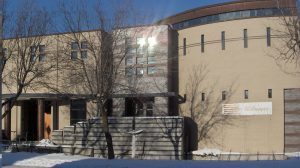Chani, like many young Jews in the Greater Toronto Area, is desperate to move out of her three-bedroom starter home to accommodate her growing family.
But in today’s record-breaking real estate market, unless you’re in the top one per cent of earners, buying into an established Jewish community in the GTA can seem impossible.
Four years ago, Chani, 32, and her husband bought a three-bedroom home on Esther Crescent in Thornhill in order to be in an established Jewish neighbourhood with other young Jewish families, one with an eruv and near synagogues.
“It took us four years to find a home… it was such slim pickings,” she said.
As difficult as it was then to buy a starter home, Chani said that now that she has four children and would love to upgrade to a four-bedroom home in the same area, it seems impossible.
“Sure we could sell this house and make a profit on it, but where would we go?”
Jacob Berkenblit, a real estate agent at Right at Home Realty, said many people looking to buy homes in Jewish areas with established Jewish infrastructure are getting “priced out.”
“They have a set budget in mind and look in a certain area, and the way housing is going now… the longer you wait, it’s not going to get cheaper,” he said, adding that demand for certain areas drives up prices.
Berkenblit said 2,000- to 3,000-square-foot, four-bedroom homes in the Thornhill area of Bathurst and Centre streets are selling for around $920,000.
He said while some of his Jewish clients are looking to buy in established Jewish areas such as Thornhill and Bathurst Manor, others are being forced to consider other up and coming areas of the city.
“A lot of clients are looking in… the Wilson [Avenue] and Bathurst area, or just north of there. They’re looking in the St. Clair and Oakwood [avenues] area, Bathurst and St. Clair – that’s the hot spot right now,” Berkenblit said.
Oakwood Village is a neighbourhood in Toronto’s west end between Eglinton and St. Clair that’s close to a number of synagogues and Jewish centres, including the Village Shul, Beth Sholom Synagogue and Beth Torah Congregation.
He said that for Orthodox families, buying a home in a Jewish area is a top priority.
“You’re not buying a house, you’re buying into a community… The factor of community, for religious Jews, is first and foremost,” Berkenblit said. “They want to buy into an area where their parents are, where their Jewish friends are.”
But even those who are willing to move further away from the city in the hope of finding more reasonably priced homes are still struggling to break into the market.
A three-bedroom townhouse near Bathurst and Highway 7 was listed recently above $778,000, while another three-bedroom condo/townhouse near Bathurst and Centre was listed for $840,000.
In Oakwood, which is considered more affordable, a couple of three-bedroom homes were recently listed for $699,000 and $749,000, respectively.
And because starter homes in the GTA are in such high demand, they often elicit bidding wars, which drives up the price even further.
“The constant joke in our house is, we could move to Detroit… we joke about it, because we could get so much more bang for our buck,” Chani said.
Sandi Pelly, UJA Federation of Greater Toronto’s director of capacity building for the social services, said the housing market seems to have affected where young Jews are settling.
“At federation in Toronto, we sort of have a conversation about how far the boundaries go, because we know that there are young families moving to the north, east and west of the city,” Pelly said.
“There are families moving into Thornhill Woods and farther north, because they can’t afford to live in the city, and then there are the families who are moving to Barrie and Ajax and Oakville.”
She said that based on the 2011 census, there are 188,000 Jews in Toronto – only a four per cent increase from 2001, when there were 180,000 Jews.
“But we’re not counting some of the Jews who are moving to Ajax or Barrie or Oakville,” she said.
In Barrie, the Jewish population more than doubled – from 715 to 1,445 – in 10 years. Oshawa’s Jewish population grew by 84 per cent from 2001 to 2011 – from 905 to 1,670.
In 2001, there were 34,435 Jews in Vaughan. Ten years later, the census determined the Jewish population in Vaughan had jumped to 47,135. The area surrounding Joseph and Wolf Lebovic Jewish Community Campus, on Bathurst north of Rutherford Road, experienced the largest increase of any Jewish community in York Region in the last decade, growing by more than 11,600 people.
Jason Leizer, 45, said he and his wife decided to move with their three children to Ancaster, Ont., (a suburb of Hamilton) about five years ago after getting priced out of the Toronto real estate market.
He said when his third child was born, they looked to upgrade from a semi-detached three-bedroom house in the St. Clair and Oakwood area to a four-bedroom house in Toronto.
“Even Thornhill, which we didn’t want to move to anyway, it didn’t matter – the GTA wasn’t affordable,” Leizer said.
They sold their three-bedroom home for $750,000 and bought a four-bedroom house that is double the size for $610,000.
Leizer said that although they did trade a faster-paced life in Toronto for a slower pace in Ancaster, they didn’t have to compromise their desire to be part of a Jewish community. As a volunteer with the Hashomer Hatzair Zionist youth movement and members of the Conservative Beth Jacob Synagogue in nearby Hamilton, and with his two youngest children enrolled in Hamilton’s Kehila Jewish Community Day School, Leizer said being involved in the Jewish community is easy.
“If you want to be involved, you’re involved… I feel like I’m more involved now than I have ever been in the Jewish community. We have a stronger connection than we would have otherwise… in Toronto.”
Anita Benabou Rozenblat and Brittney Rozenblat of the Rozenblat Realty Group said that although the real estate market in Montreal is not as inflated as in Toronto, people who want to live in established Jewish areas also must pay a premium.
“When families who are Jewish want to live in Côte St. Luc or Hampstead, the price is different… In Côte St. Luc, if you’re talking about an average size [starter home], that can cost you about $500,000 and up… The same identical home can be found [elsewhere] on the island of Montreal for as low as $250,000,” said Benabou Rozenblat.
Rozenblat, a 25-year-old newlywed, said she recently moved into Côte St. Luc and had to pay a premium on her house and taxes “through the tuches… but for me it’s worth it, because I’m near my friends, near my family, near my synagogue. It’s a little less favourable, because I’d want to live in a bigger house, but this is what we’re starting off with.”
She said that it doesn’t seem like there are any new Jewish neighbourhoods forming, but many Jews are continuing to settle in Dollard-des-Ormeaux, a suburb about 25 minutes outside of Montreal. “There, the homes are much more affordable, within the $250,000, $300,000 price range.”
Lesli Green, Federation CJA’s chief communications officer, said that while there haven’t been any major changes in Montreal regarding where Jews are choosing to settle over the last several decades, the Jewish population in the West Island, a residential suburb, has grown steadily.
“What we’re finding is that, where Dollard-des-Ormeaux was a concentration, now some people are moving to other parts of the West Island as well. It’s widening a bit,” Green said.
She said Côte St. Luc, the area with Montreal’s largest Jewish population, is home to about 20,000 Jews. The West Island has the city’s second-largest Jewish community, but Hampstead has the highest concentration of Jews, with about three-quarters of its residents identifying as Jewish.
Benabou Rozenblat said that in Côte St. Luc, there is a new development of about 50 townhomes that are meant to be affordable options for young families, but with price tags of $400,000 to $500,000, people are still finding them unaffordable.
Rachel, 29, who is married with two kids, said she is currently searching for a home in Côte St. Luc, because she wants a home close to her children’s Jewish day school.
“Even the new construction that is supposed to be affordable for young families is not really affordable. We have to go into an area of Côte St. Luc that is a little bit deeper and further away from the school, but at least you can stay in the community and you’re around other Jewish people,” she said.
“But I have friends who have condos in Côte St. Luc and are looking to buy houses, but because the prices are so high, they’re waiting to have more children because they don’t have the space for them.”
She said despite the fact that homes in the Jewish community are much more expensive than other parts of the city, she hasn’t given up on her desire to live there.
“I think it’s important for us, mostly, that the kids are close to the school. I would rather give up my car and have one less payment to make for a car and put that toward my mortgage because it would be better for my kids.”






